EQUINE WELFARE NETWORK PROFILE
All About Equine Animal Rescue

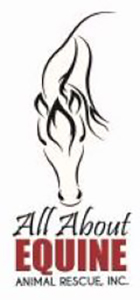
All About Equine Animal Rescue
2222 Francisco Drive 220-174
EL DORADO HILLS, CA 95762
*Physical address available on request.
Phone: 916-520-4223
MAKE AN INQUIRY
View our WEBSITE
EIN: 27-0384523Founded: 2009
View our PHOTO GALLERY
Profile Last Updated June 27, 2025Public Charity
NEXT CHAPTERS! Click here to view listings of our adoptable equines: Allie - Blue - Bonnie - Brax - Clyde - Ella - Jack - Jackson - Jasper - Karli - Liza - Maia - Niko - Noah - Red - Rimes - Sophia - Theo - Trinity
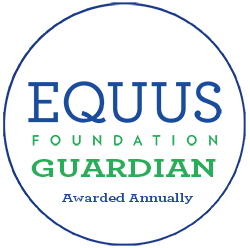
2025
The Guardian Seal of Transparency is awarded annually to recognize an organization's commitment to transparency and accountability by their willingness to make comprehensive data about their programs, horse care practices, and governance available for public scrutiny. The Guardian Seal of Transparency is NOT an endorsement.
Awarded Annually
Last Updated: September 21, 2025
Last Updated: September 21, 2025
Finnegan
Our Equine Ambassador

Finn is a 2014 grade gelding that was born at AAE after his mom was rescued from an auction be another rescue. He was very sick as a young foal, but had a strong will to survive. He became a volunteer favorite before he was adopted as a yearling. He was a character from day one. His antics were not appreciated by his adopter. Flirting with her three mares causing them to excape their paddocks to get to his, scaling a five foot fence to chase the trailer down the road, and simply being the footloose and fancy free kid he was. Sadly for him, he was returned to AAE. Team AAE was happy to have him back, and he's been one of our Ambassadors since. He's one of our most laid back, trustworthy, and dependable horses that many of our new volunteers can count on to show them the way. Finn is one in a million, and he has a forever home here where he'll be loved to eternity.
MISSION & PROGRAMS
Mission:All About Equine Animal Rescue, Inc. (AAE)'s mission is to rescue and rehabilitate abused, neglected, abandoned, and/or slaughter-bound animals, primarily equines (wild and domestic); to provide animals with food, shelter, care, handling, and veterinary care, as needed; to utilize a strategic process for matching healthy, rehabilitated animals with compatible, loving, and permanent adoptive homes; to provide long term care for unadoptable animals; and to educate the community about abused, neglected, abandoned, unwanted, and/or slaughter-bound animals, primarily equines (wild and domestic).
Our organization provides programs involved with equine rescue, adoption & retirement
Our organization provides outreach and/or public education programs involving horses.
Over 90% of our total programs and services are equine-related.
Our organization is directly responsible for the care and shelter of equines involved in our programs.
Our organization does not CURRENTLY use satellite, overflow, foster, and/or outreach facilities.
Please describe what steps your organization takes to ensure that:
1) all interactions between your equines and people are mutually beneficial and conducted in accordance with the Guidelines for Human-Equine Interactions stated below;
2) all equines in the care of our organization and/or equines that participate in the organization's program have access to clean drinking water at all times; nutritious food in sufficient quantity, including natural forage such as pasture grass and/or hay; appropriate veterinary, farrier, and dental care; shelter and protection from the weather; sufficient safe space to move around comfortably on a daily basis; and daily opportunity to freely interact and have contact with other equines:
1) Regarding human-equine interactions, our horses do not typically attend outreach events Similarly, collaborative efforts are not hands-on with horses.
There are horse-human interactions involved in our horse care volunteer program. Our volunteers provide twice daily care for our horses. All new volunteers involved with horse care participate in a New Volunteer Orientation and Basic Safety Training before actively participating in horse care. They are introduced to the basics of how to handle and care for the horses, then learn through the experience of caring for the horses at the rescue. Our volunteers learn about compassionate care, nutrition, proper handling, grooming, hoof handling and care, learning/training philosophies, common health issues, medicating and treatments, common veterinary care, overpopulation, and responsible ownership. The horses benefit from quality care, nutrition, and care and attention from our volunteers. The volunteers benefit from hands-on experience that helps make them better caregivers, better horse owners, better future horse owners, and stronger advocates for horses. We currently have one long-time collaborative volunteer group that serves clients with autism, TBIs, and other cognitive disorders. Their clients volunteer with their staff to help provide care for our mini horses, mini donkey, mini mule, and other farm animals (e.g. goats, tortoise, etc.)
2) All of AAE's horses are routinely fed twice daily and/or have grazing access. Their water supply is also checked twice daily and cleaned if necessary. They all have sufficient space and shelter is available. Veterinarian care is provided annually or as necessary (including dental care) and regular farrier service is also scheduled.
Equine Transition Services:
Overview of our programs involved with rescue, rehabilitation, retraining, re-homing and/or retirement:
All About Equine Animal Rescue, Inc. (AAE) rescues horses from a variety of situations including abandonment and neglect, as well as surrenders due to death and family health/crisis situations, military deployment, and financial crises. AAE also supports local law enforcement (e.g., El Dorado County, Sacramento County, Lassen County, San Joaquin County and Lake County). In addition, AAE collaborates with other organizations in support of large scale rescues and hardship cases, overpopulation situations, herd reduction efforts, and hardship cases (e.g., Dreamcatchers Wild Horse and Burro Sanctuary, Auction Horses Rescue, Fleet of Angels, Oakdale Equine Rescue, Virginia Range Wild Horse Sanctuary, Hidden Valley Wild Horse Sanctuary, Lifesavers Wild Horse Rescue, Performance Equine Rescue Network, Freedom Horse Rescue, and more).
Upon intake, all equine are quarantined, evaluated, and receive needed veterinary care; they are provided dental and farrier care, vaccines and deworming when health-appropriate and feeding/supplement programs are individually designed based upon individual health needs. Microchips are administered to all equine, if they don't have one.
AAE's primary purpose is to rescue, rehabilitate and rehome horses-in-need (wild and domestic). Typically AAE provides gentling and basic handling to unhandled horses (wild or feral). Domesticated horses are evaluated for handling and riding knowledge. AAE aims to provide ongoing learning (training or relearning) for all horses while at AAE. Each horse's temperament, skills and abilities are evaluated and considered when interviewing potential adopters. The horse's needs are the top priority when matching potential adopters to ensure a successful adoption. Occasionally a horse becomes an AAE resident either for participation in AAE programs (e.g. new volunteer orientation, outreach, and youth/adult programs) or in sanctuary in the case of an older horse or a horse with extensive needs. AAE Program horses may be retired as sanctuary horses to ensure their remaining days are the best they can be.
AAE also supports the community with during times of critical support (i.e. wild fires) by assisting with animal housing, transportation, volunteer support, etc.
Outreach and/or Public Education:
AAE's Outreach/Education team attends local community activities including fairs, expos, school activities, chamber events, state and corporate giving programs, and fundraising events to share information about AAE programs, adoptable horses, and to educate the community about the plight of horses, the unwanted horse, overpopulation, slaughter, wild horses, older horses, and humane and compassionate care.
AAE currently collaborates with a local organization to provide volunteer-based educational and experiential learning and social development opportunities to clients with autism spectrum disorders, traumatic brain injuries, and similar conditions while participating in the care of the animals and related activities. These opportunities will expand as the transition to our new property and infrastructure are completed.
AAE also supports corporate team building activities through special volunteer projects to support AAE animal care and facililty needs.
AAE also collaborates with Scouts, National Charity League, schools, teams, and other organizations to give children and adults an opportunity to learn about horses through volunteer activities.
Research/Medical Use of Equines:
Our organization has never made, and would not ever consider making, equines available for research studies or medical training that involves invasive procedures and/or that which may cause pain or suffering to the equine.
Religious Affiliation:
Our organization does not promote religious education, religious purposes, or a specific religious faith or use donations for religious education or religious purposes; require participants to be of a certain faith; require participation in religious, instruction, activities or services; or require participation in prayer, worship, religious instruction or other religious activities as a condition of receiving social or secular services offered.
Auction Donation:
Our organization has never allowed, or would not consider allowing, an equine to be sold, transferred, released, or otherwise placed into possession of any person or organization that would cause or allow the equine to be sold at auction for slaughter.
Our Programs/Activities that are not equine-related and/or involving animals other than equines:
Though AAE is primarily an equine rescue organization, we occasionally take in other farm animals and small animals as part of the rescue program. We have taken in cows, pigs, goats, sheep, alpacas, dogs/puppies, cats/kittens, chickens, and a tortoise.
As AAE completes the transition to our new location, complete infrastructure, and obtain requisite permits, AAE will reinstate past equine-assisted programs for youth and adults and expand program offerings. Until then, they are temporarily on hold.
POLICIES: INTAKE, ASSESSMENT & TRAINING
Prior to a horse being accepted and/or arriving at the facility, the organization has the following policies in place:The owner of a potential equine is interviewed over the phone or in person prior to seeing the equine
The equine is evaluated at its place of residence
The owner completes an application/contract which constitutes the agreement between the owner and our organization when the equine is acquired from the equine's owner other than by seizure or by abandonment
The owner is financially responsible for the shipping of the equine to and from the organization
If health records are not available or are out-of-date, our veterinarian will administer appropriate vaccinations
Not Checked:
A health certificate signed by a veterinarian and dated no more than seven days prior to arrival is provided to our organization either prior to or upon arrival of the equine attesting to the health status of the equine
A health certificate signed by a veterinarian and dated no more than seven days prior to arrival is provided to our organization either prior to or upon arrival of the equine attesting to the health status of the equine
Trial Period: Check all that apply:
Equines are not taken on trial
Upon intake, the organization has the following quarantine policy in place:
The equine is confined to a designated and separate area for isolation and quarantine at the facility for a prescribed period of time
Not Checked:
The equine is confined to a designated and separate area for isolation and quarantine off-site for a prescribed period of time
The equine is not quarantined
The equine is confined to a designated and separate area for isolation and quarantine off-site for a prescribed period of time
The equine is not quarantined
The typical length of quarantine is: 10 to 20 days
Following arrival of the equine at the facility, the following is performed:
Physical examination to include temperature, pulse and respiration by a veterinarian upon arrival
Physical examination to include temperature, pulse and respiration by a trained staff member upon arrival
A Henneke Body Conditioning Score or other body conditioning score is assigned by a veterinarian upon arrival
Photographs are taken of each equine upon arrival at the facility and kept with the equine's health records
Physical examination by a farrier
Physical examination by a dentist
The equine is microchipped if the equine has not been microchipped
Not Checked:
A Henneke Body Conditioning Score or other body conditioning score is assigned by a trained staff member upon arrival
A Henneke Body Conditioning Score or other body conditioning score is assigned by a trained staff member upon arrival
Horses are assessed for following skills and behaviors:
Retrieval from a pasture/paddock
Leading with a halter and lead rope
Temperament, disposition and attitude, such as rated from very calm to very high spirited
Saddling
Bridling
Lunging
Loading onto and unloading off a trailer
Mounting and dismounting
Riding at the walk
Riding at the trot
Riding at the canter
Riding by a beginner and/or unbalanced rider
Tolerance to unusual objects and loud noises
Known vices, i.e., cribbing, biting, kicking, weaving, stall walking, etc
Grooming
Bathing
Tolerance to multiple handlers at the same time
Not Checked:
Jumping
Driving (Pulling a carriage)
Clipping
Jumping
Driving (Pulling a carriage)
Clipping
Our organization has the following policies and procedures in place pertaining to the ongoing assessment of horses in its care:
Physical examination by a veterinarian at least annually
The Henneke Body Condition score or other body conditioning score is updated at least annually by the veterinarian
Vaccinations are administered at least annually
Photographs are taken of each equine annually and kept with the equine's health records
Equines at our facility may be treated by an equine chiropractor
Equines at our facility may be treated by an equine acupuncturist
Equines at our facility may be treated by an equine massage therapist
Not Checked:
The Henneke Body Condition score or other body conditioning score is updated at least annually by a trained staff member
Photographs are taken of each equine monthly and kept with the equine's health records
Equines at our facility may be treated by an equine nutritionist
The Henneke Body Condition score or other body conditioning score is updated at least annually by a trained staff member
Photographs are taken of each equine monthly and kept with the equine's health records
Equines at our facility may be treated by an equine nutritionist
Our organization has the following policies and procedures in place pertaining to the weight-carrying or workload capabilities of horses/equines that are ridden in our care:
Our organization evaluates the weight-carrying and workload limitations for each equine that is ridden at least annually
Our organization maintains a written record of the weight-carrying and workload limitations for each equine that is ridden
Not Checked:
Our organization does not evaluate the weight-carrying and workload limitations for each equine that is ridden
No equines are ridden; not applicable
Our organization does not evaluate the weight-carrying and workload limitations for each equine that is ridden
No equines are ridden; not applicable
The following variables are considered in determining the weight-carrying and workload limitations for each equine that is ridden:
Equine age, weight, breed, body condition, fitness, balance, health and soundness
Weight and proper fit of the saddle and other equipment
Terrain and footing in the working environment
Duration and frequency of working sessions, as the frequency with which an equine is subjected to maximum weight carrying and/or workload
Temperature and/or weather conditions
Not Checked:
Equine conformation to include the top line, length of back, strength and width of loin, bone density (measured by the circumference of the cannon bone just below the knee)
Size, shape, condition and angle of the hooves
Participant weight, height, body proportions, balance, fitness and riding skills as well as behavioral issues and safety concerns
Nature and pace of work, repetitive or varied, radius of turns, degree of incline and regularity of footing when equine is subject to maximum weight-carrying capacity
Seasonal impact on the equines' workload and weight-carrying capabilities and limitations
Our organization does not evaluate the weight-carrying and workload limitations for each equine that is ridden
No equines are ridden; not applicable
Equine conformation to include the top line, length of back, strength and width of loin, bone density (measured by the circumference of the cannon bone just below the knee)
Size, shape, condition and angle of the hooves
Participant weight, height, body proportions, balance, fitness and riding skills as well as behavioral issues and safety concerns
Nature and pace of work, repetitive or varied, radius of turns, degree of incline and regularity of footing when equine is subject to maximum weight-carrying capacity
Seasonal impact on the equines' workload and weight-carrying capabilities and limitations
Our organization does not evaluate the weight-carrying and workload limitations for each equine that is ridden
No equines are ridden; not applicable
Horses provided formal training (groundwork or riding): As needed; no set schedule
Additional information about our intake, assessment & training policies and practices:
AAE collects as much information about each horse as possible before intake. Owner requesting surrender must complete a relinquishment form (or provide similar information) and transfer ownership. Horses are assessed for being approachable and touchable; for haltering, leading, and basic groundwork; and for horses that are known ridable, for saddling, bridling, and riding, as appropriate riding evaluator is availabe, depending upon information obtained during interview. Training schedule is dependent on evaluation and needs, but goal is ongoing progress while at AAE.
Exceptions to above may be made based on information available, condition of horse, handleablability horse (eg, wild/feral horses and stallions will be seen by vet once safe and halterable; health and behavior of horse will guide approach, etc)
Quarantine period is typically 14 days and will be extended if indicated (eg, upon vet direction, if health suggests with cough, runny nose, discharges, known exposures, origination of intake, etc).
Coggins testing is done if interstate travel is involved.
Horses are not examined as in "the day of arrival", unless there's an urgent issue; they are typically scheduled and seen by our vet shortly after arrival for exam while in quarantine, and any needed diagnostics, treatment, and if stable, dental, vaccine, microchip, sheath cleaning (if male). If horse is feral/unhandled, unless there's a health concern/injury, the horse is seen once halterable/handleable and safe.
POLICIES: BREEDING
The organization has the following policies related to breeding and stallions:Our organization does not conduct breeding of equines owned or under the care of our organization.
Our main facility where our organization conducts its programs does NOT breed equines.
One or more of the facilities where our organization conducts its programs, including foster/temporary care facilities, are permitted to house stallions
Not Checked:
One or more of the facilities where our organization conducts its programs, including foster/temporary care facilities, breeds equines
One or more of the facilities where our organization conducts its programs, including foster/temporary care facilities, breeds equines
Additional information about our breeding policies and practices:
AAE takes in pregnant mares, mare/foal pairs, and colts/stallions. Any colt or stallion taken in or born at the AAE Facility is gelded as soon as safely and medically possible. Colts/stallions may be housed temporarily until gelding is possible (i.e. when age appropriate, when gentled and safely handable, and/or when health appropriate, if compromised). Colts/stallions must be gelded before they leave AAE on adoption.
POLICIES: EUTHANASIA
The organization has the following policies related to euthanasia:Our organization will never have an equine euthanized for space
Our organization will have an equine euthanized upon the recommendation of the veterinarian if the equine is a threat to itself, other equines, or people
Our organization will have an equine euthanized upon the recommendation of the veterinarian after all reasonable treatment options have been explored
Euthanasia is done on site when possible to decrease trauma from transport
Euthanasia is done at the veterinarian's facility
Disposal of the carcass is handled within 24 hours
Not Checked:
Our organization will never have an equine euthanized under any circumstances
Our organization will never have an equine euthanized under any circumstances
The following are authorized to administer the procedure for your organization in accordance with state laws:
Veterinarian
Not Checked:
A certified euthanasia technician
Senior staff with appropriate training
Employee of animal control shelter or humane society with appropriate training
Veterinary student under the supervision of a licensed veterinarian
Not applicable. Our organization prohibits euthanasia under any circumstances
A certified euthanasia technician
Senior staff with appropriate training
Employee of animal control shelter or humane society with appropriate training
Veterinary student under the supervision of a licensed veterinarian
Not applicable. Our organization prohibits euthanasia under any circumstances
Additional information about our euthanasia policies and practices:
All About Equine Animal Rescue (AAE) is a no-kill organization, and will only consider euthanasia in a quality of life, serious illness or injury with poor prognosis, or dangerous equine situations after consultation with our veterinarian.
AAE follows GFAS principles:
“•Euthanasia, administered under the strict supervision of a licensed veterinarian, is only to be used as a final option after all other options have been considered and either attempted or judged impossible. Euthanasia is not used as management tool. Equines are not euthanized as a means to create space for more animals”
“Examples of cases where euthanasia may be accepted are:
• Incurable disease/injury that is likely to cause unmanageable pain or suffering.
• Disease/injury where treatment is likely to cause unreasonable pain or suffering.
“Administration of Euthanasia
• A licensed veterinarian or his/her authorized representative, ideally with an established relationship with your sanctuary/rescue and the equine, recommends and performs humane
euthanasia.
• Furthermore, this veterinarian, or qualified personnel under the direct guidance and supervision of the veterinarian, must be knowledgeable and skilled in performing euthanasia in a compassionate and professional manner. It is performed so that it avoids distress to the equine.
POLICIES: RE-HOMING
View Re-homing AgreementOur organization has the following re-homing (adoption/purchase) policies and procedures in place:
All potential adopters/purchasers complete a written contract which constitutes the agreement between our organization and the new owner
Our organization does NOT re-home an equine to first time equine owners
Our organization will only re-home an equine to a location where another equine resides
Potential adopters/purchasers must visit our organization and be observed with the equine on site
The distance of a potential adopter/purchaser's home from our facility is a consideration for when re-homing an equine
Adopters/purchasers are NOT required to provide updates
Not Checked:
Our organization conducts a site visit of the adopter/purchaser's facility before the transfer of the equine to the adopter/purchaser's facility
Potential adopters/purchasers are encouraged to do a short-term, on-site foster with the equine
Our organization conducts a site visit of the adopter/purchaser's facility before the transfer of the equine to the adopter/purchaser's facility
Potential adopters/purchasers are encouraged to do a short-term, on-site foster with the equine
Our organization has the following policies and procedures related to horses that need to be retired, are no longer able to contribute to the mission of the organization, and/or are no longer manageable:
Equines may remain at our organization for their lifetimes
Equines may be found suitable homes by our organization
In the case an equine is unmanageable and demonstrates repeated dangerous behaviors, the equine may be euthanized upon the recommendation of the veterinarian
In the case an equine is unsound and/or unhealthy and cannot be treated to relieve suffering, the equine may be euthanized upon the recommendation of the veterinarian
Not Checked:
Equines may be returned to their owners
Equines may be sent to auction
If a suitable home cannot be located within 12 months, the equine may be euthanized
The organization will accept financial responsibility for equines in the current care of the organization that need to be retired or are no longer able to contribute to the mission of the organization if all alternatives have been explored to find the equine an appropriate placement and space is not available for the equine to remain at the organization.
Equines may be returned to their owners
Equines may be sent to auction
If a suitable home cannot be located within 12 months, the equine may be euthanized
The organization will accept financial responsibility for equines in the current care of the organization that need to be retired or are no longer able to contribute to the mission of the organization if all alternatives have been explored to find the equine an appropriate placement and space is not available for the equine to remain at the organization.
The uploaded Re-homing agreement includes the following re-homing (adoption/purchase) statements:
The agreement reflects that any individual or organization in possession of the equine as of the date of the agreement and any time thereafter is bound to not sell the equine at auction for slaughter or allow the equine to be sold, transferred, released, or otherwise placed into possession of any person or organization that will cause or allow the equine to be sold at auction for slaughter.
The agreement states that should the adopter decide to re-home the equine, our organization must grant approval of any individual or organization intending to take possession of the equine for any reason prior to the equine being placed into the possession of such individual or organization, including being provided written notification of the name, address, and telephone number of any individual or organization intending to take possession of the equine for any reason.
The agreement states that the terms of our organization's agreement will be binding on any future individual or organization taking and/or in possession of the equine for any reason.
The agreement states that re-homed equines cannot be bred
The agreement states that if there is any breach of contract the equine must be returned to our organization
The agreement states that our organization reserves the right to make scheduled visits
The agreement states that adopters/purchasers can return an equine to our organization free of charge
Our organization microchips all equines that are not already microchipped before the adoption and/or transfer of the equine if the organization has the authority to microchip the equine.
Not Checked:
The agreement states that the re-homed equine CANNOT be sold, adopted, transferred, auctioned, released, given away, or otherwise placed into the possession of another individual or organization under any circumstances and must be returned to our organization should the adopter decide that he/she is no longer able, or no longer wishes, to care for the equine.
The agreement states that should the adopter decide to re-home the equine, the adopter must grant the organization first right of refusal prior to the equine being placed into the possession of any individual or organization intending to take possession of the equine for any reason.
The agreement states that should the adopter decide to re-home the equine, our organization must be notified of the name, address, and telephone number of any individual or organization intending to take possession of the equine for any reason prior to the equine being placed into the possession of such individual or organization.
The agreement states that our organization reserves the right to make unannounced visits
The agreement states that adopters/purchasers can return an equine to our organization for a fee
The agreement states that adopters/purchasers are required to provide updates (photos, vet records) for one year
The agreement states that adopters/purchasers are required to provide updates (photos, vet records) for two years
The agreement includes the microchip number of the equine.
The agreement states that adopters/purchasers are required to provide updates (photos, vet records) for as long as the adopter/purchaser is responsible for the care of the equine
None of the statements are included.
The organization does not re-home equines under any circumstances; our organization retains custody of our equines and ensures care of the equines for their lifetimes.
Our organization does not have the authority to transfer ownership and/or does not own any of the equines involved with our programs.
The agreement states that the re-homed equine CANNOT be sold, adopted, transferred, auctioned, released, given away, or otherwise placed into the possession of another individual or organization under any circumstances and must be returned to our organization should the adopter decide that he/she is no longer able, or no longer wishes, to care for the equine.
The agreement states that should the adopter decide to re-home the equine, the adopter must grant the organization first right of refusal prior to the equine being placed into the possession of any individual or organization intending to take possession of the equine for any reason.
The agreement states that should the adopter decide to re-home the equine, our organization must be notified of the name, address, and telephone number of any individual or organization intending to take possession of the equine for any reason prior to the equine being placed into the possession of such individual or organization.
The agreement states that our organization reserves the right to make unannounced visits
The agreement states that adopters/purchasers can return an equine to our organization for a fee
The agreement states that adopters/purchasers are required to provide updates (photos, vet records) for one year
The agreement states that adopters/purchasers are required to provide updates (photos, vet records) for two years
The agreement includes the microchip number of the equine.
The agreement states that adopters/purchasers are required to provide updates (photos, vet records) for as long as the adopter/purchaser is responsible for the care of the equine
None of the statements are included.
The organization does not re-home equines under any circumstances; our organization retains custody of our equines and ensures care of the equines for their lifetimes.
Our organization does not have the authority to transfer ownership and/or does not own any of the equines involved with our programs.
Our organization requires references from the following:
Veterinarian
Farrier
Personal/Other
Not Checked:
Not applicable or no references required.
Not applicable or no references required.
Transfer of ownership occurs: Immediately (at the time of adoption/purchase) or less than one year
The average equine re-homing (adoption/purchase) fee received by your organization:
$751 to $1,000
Additional information about our rehoming policies and practices:
On occasion, exceptions may apply, e.g., AAE may adopt a horse to a first time owner if new owner demonstrates exceptional understanding/experience and agrees to working with a trainer/instructor, has available resources for learning/advising; AAE conducts initial home evaluation via photos and GoogleEarth observation, and a home visit is scheduled, if concerns arise.
EQUINE CARE & SHELTER/FACILITY INFORMATION
Our organization does not CURRENTLY use satellite, overflow, foster, and/or outreach facilities.Total facilities at which our organization cares for and shelters horses used in our programs: 1
All About Equine Animal Rescue, Inc. (AAE)
*Physical address available on request.
Currently operational
Total number of horses/equines currently involved with your programs, under your care, and/or owned by your organization at this facility: 58
Total number of horses at this facility NOT INCLUDING those counted above: 1
Maximum capacity of horses at this facility: 65
Does your organization own, lease or use a part of this facility? Own
Provide the contact information for the individual or organization responsible for investigating abuse in the county where the facility is located, including mailing address, email address, and phone information.
El Dorado County Animal Services 6435 Capitol Ave. Diamond Springs, CA 95619 Craig Hall craig.hall@edcgov.us 530-621-5795; 530-621-6638
Does your organization conduct Equine Assisted Services (EAS) at this facility in accordance with the EQUUS Foundation Guidelines on Qualifications of Organizations Conducting Equine Assisted Services (EAS)? No
ADDITIONAL INFORMATION ABOUT THIS FACILITY:
Early in 2024, AAE was approached by law enforcement in Sacramento and Lassen counties to ask us for help with two seizures. Sacramento Co. had 5 (2 cruelty cases and 3 abandoned). Lassen Co. had a large abandonment case. We agreed to take 9 mares and 6 foals. Shortly after their arrival, we were unexpectedly blessed with two newborn foals (Noah and Tyler) which temporarily had us over our maximum capacity of 65.
AAE's 61-acre property was acquired as undeveloped land, and improvements are ongoing. Pastures and large paddocks are not lighted, but operations/functional areas are adequately lighted including main building/hay barn, and the 6- and 8-stall mare motels. There are three eight-stall mare motels (24 stalls, 12x12 covered, 12x12 uncovered). One of the 8-stall mare motels was recently dismantled for construction of new 8-stall barn starting this year. Areas around the main barn, main mare motel and caretaker housing have lights. We are testing solar lighting options for future installation because electricity and solar power is limited to the improved area.
AAE has one large storage building/barn used for storing hay, supplements, other feed, equipment, supplies, and other miscellaneous items. No horses are housed in the storage building/barn. There are 28 small (24x24) to large 72x72) paddocks used for turnouts from stalls, feeding supplements, temporary or longer term housing or transitioning from one area to another. The majority of horses and other equine at AAE are typically in pastures (9 acres or more) or larger paddocks (1/4 acre) with 24/7 turn out 24/7. A small number of horses under veterinary care or treatment are housed in stalls for 24/7 care, confinement (if mobility issue), treatment, observation, or other reason. Another small group of seniors or malnourished/rehabbing horses are brought into stalls/small paddocks 1-2 times a day for meds, treatment, special feed or supplements, then turned back out to pasture. Paddocks/pastures will be rotated as more cross-fencing is installed.
All stalls in the mare motels have rubber mats over entire 12'x 24' ground surface area for improved footing, but it's proven to be less effective than intended. We have good drainage and traction in most areas. We had some issues with pooling water/mud in a couple stalls in one of the mare motels, but that's the mare motel that has been dismantled in anticipation of the new barn construction beginning next month. Our new barn will ultimately have concrete slab on grade foundation with stall mats and drains in each stall and drainage/traction for footing in center aisle. ** Update: the mare motel with the "pooling" issue has been dismantled in preparation for the new barn.
Mare motels are open air, no "ventilation/circulation systems". We do have fans available that move around and utilize as needed to circulate air. New barn will ultimately include box fans in each stall.
AAE has a white board for volunteers/staff that indicates by name where each horse is located. This board is updated as necessary to indicate changes (movements, additions or deletions)
We have two people that live onsite. A security system with four cameras around main operations area is maintained by professional service. Cameras can be viewed at any time. When a horse needs overnight observation, we are onsite and monitor/treat throughout the night, as needed, but we don't have a person that works throughout the night, monitoring every night.
Veterinarian Information: All About Equine Animal Rescue, Inc. (AAE) (*Main) Currently operational
Veterinarian: Diana Stolba, DVM
Clinic Name: Loomis Basin Equine Medical Center
2973 Penryn Road
Penryn CA 95663
Phone: 916-652-7645
Grounds: All About Equine Animal Rescue, Inc. (AAE) (*Main) Currently operational
Total acreage dedicated specifically to the horses: 61
Our organization has use of the following at this facility:
Structures/Barns: 3 Run-in sheds: 12
Pastures: 4 Paddocks/Pens/Turnout Areas: 28
Uncovered Outdoor Rings: 1 Covered Outdoor Rings: 1 Indoor Rings: 0
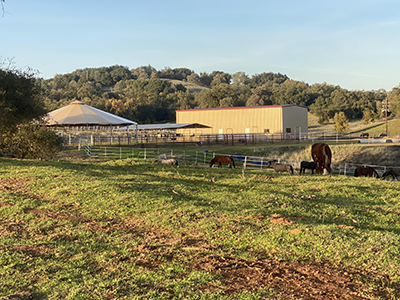
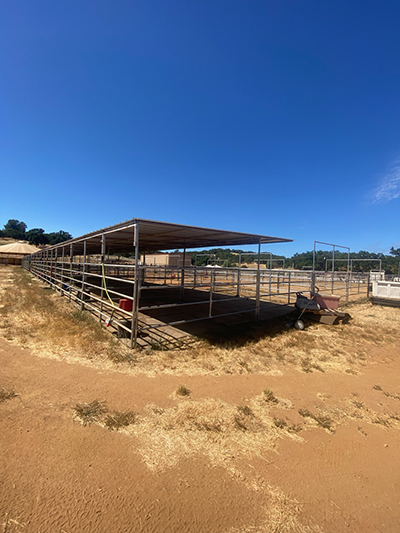
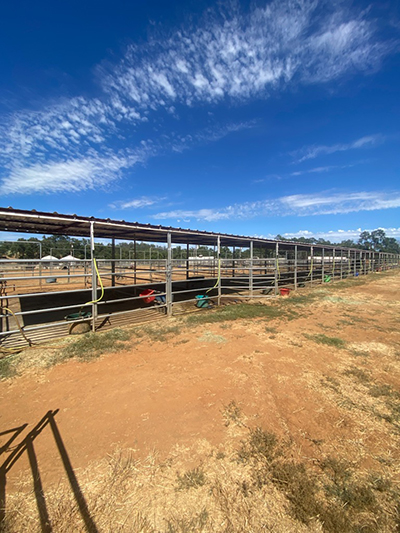
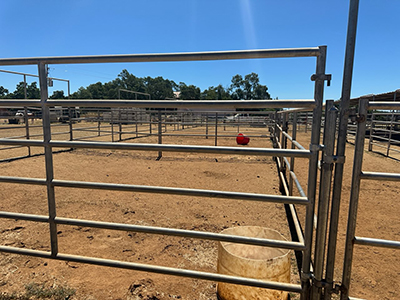
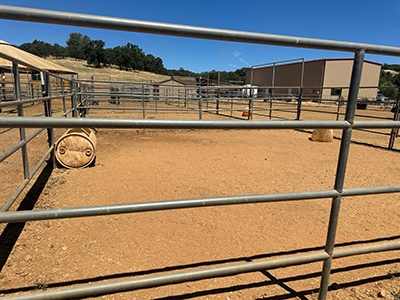
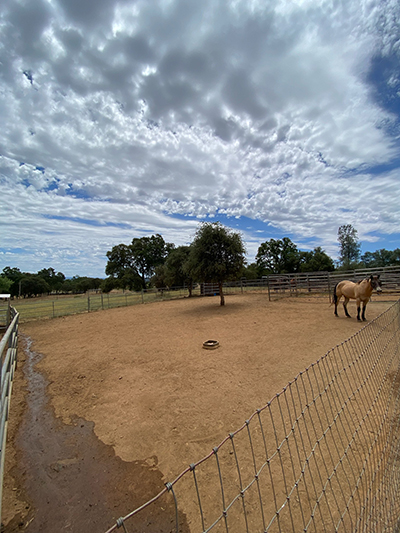
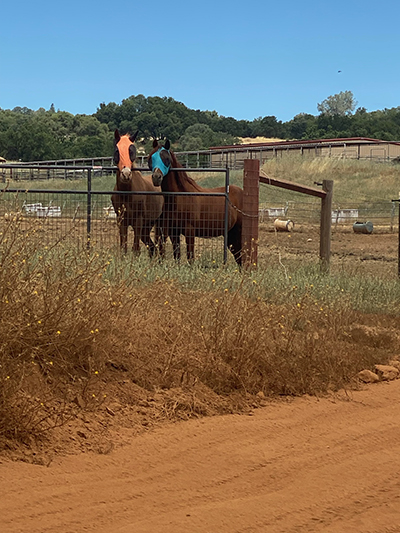
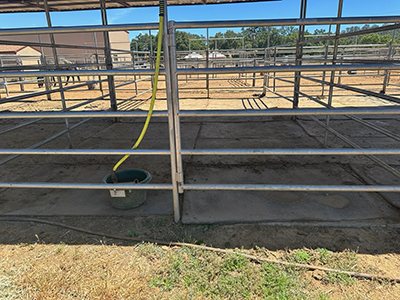
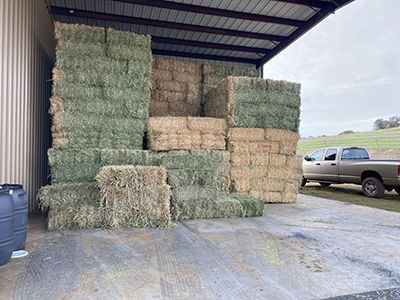
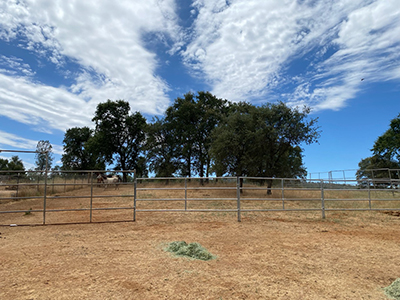
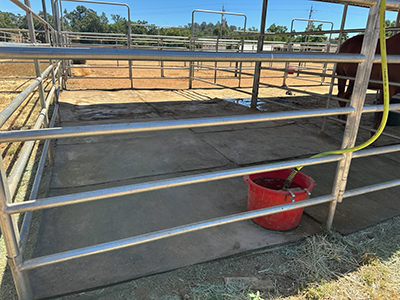
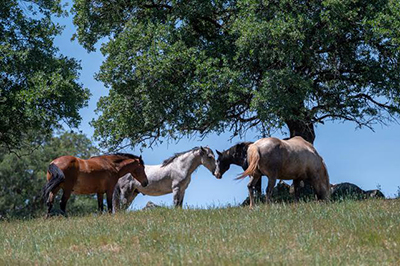
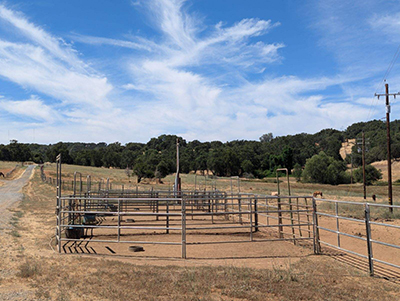
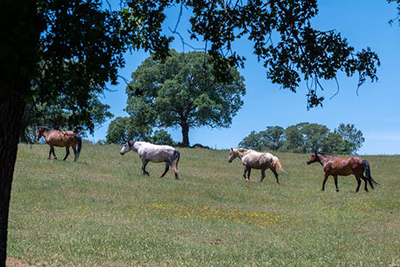
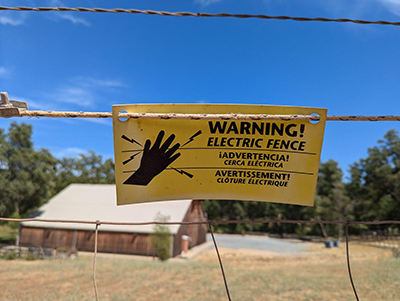
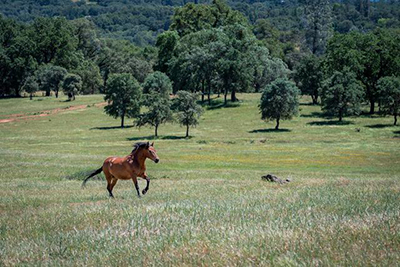
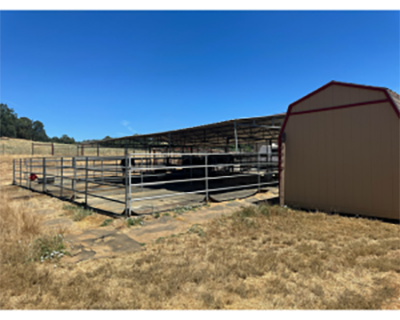
Are the organization's rules, restrictions and warnings (signage) conspicuously posted in easily accessible locations? Yes
Are the organization's emergency contacts, including veterinarian contact information, conspicuously posted in easily accessible locations? Yes
Are human and equine first aid kits easily accessible? Yes
Regarding all shelters where horses are housed including run-in sheds:
Do horses have assigned stalls in the barn/structure(s) or exclusively assigned shelter locations where they are separated from other horses with a barrier? No
How many hours per day, on average, are horses stalled or restricted to these sheltered exclusive shelter locations? 17+
How often are the stalls/shelters cleaned, i.e., kept in good repair and free of standing water, accumulated waste, sharp objects and debris? 6-7 Days a Week
Do all stalls/shelters allow horses to lie down, stand up and turn around and provide protection from inclement weather (wind, sleet, rain, snow and extreme temperatures)? Yes
Are stalls/shelters kept in good repair, with adequate ceiling height, and free of standing water, accumulated waste, sharp objects and debris? Yes
Are floors constructed and maintained for both good drainage and traction? Yes
Is there a ventilation and circulation system in place to allow free flow of air to control temperature, and humidity, and to prevent air stagnation? Yes
Is wiring inaccessible to horses and maintained for safety in all areas of facility? Yes
Are fire prevention/protection measures (fire alarms, extinguishers and sprinkler systems) maintained and in good working order? Yes
Is there adequate lighting to ensure safety in all areas of facility? Yes
How many hours per day, on average, are horses turned out:
Equines are out 4 to 8 hours per day
Equines are out 24/7
The following describes the pastures at this facility:
All pastures are fenced to prevent escape or injury
Electric fencing is used; electric wires or tape fence are visibly marked
Fencing checks, such as broken or missing planks, loose fence posts, exposed or loose nails, detached wires, etc., are done regularly
Pastures have natural protection for equines (i.e., trees)
Not Checked:
This facility does not have pastures where equines can graze on pasture grass
This facility has a written plan in place for pasture management, which includes guidelines for seeding, fertilizing, irrigation, mowing, dragging, harrowing, manure removal, removal of debris, the control of poisonous plants, and a schedule for cleaning
A dedicated staff person(s) is responsible for pasture management
Barbed wire is used for fencing
Pastures are rotated
Pastures have man-made protection for equines (i.e., shelters)
This facility does not have pastures where equines can graze on pasture grass
This facility has a written plan in place for pasture management, which includes guidelines for seeding, fertilizing, irrigation, mowing, dragging, harrowing, manure removal, removal of debris, the control of poisonous plants, and a schedule for cleaning
A dedicated staff person(s) is responsible for pasture management
Barbed wire is used for fencing
Pastures are rotated
Pastures have man-made protection for equines (i.e., shelters)
The following describes the turnout areas other than pastures at this facility:
All turnout areas are fenced to prevent escape or injury
Electric fencing is used; electric wires or tape fence are visibly marked
Turnout areas have man-made protection for equines (i.e., shelters)
Fencing checks, such as broken or missing planks, loose fence posts, exposed or loose nails, detached wires, etc., are done regularly
Not Checked:
This facility does not have turnout areas
This facility has a written plan in place for the maintenance of turnout areas, which includes a schedule for cleaning, manure removal, and dragging
A dedicated staff person(s) is responsible for the maintenance of turnout areas
Barbed wire is used for fencing
This facility does not have turnout areas
This facility has a written plan in place for the maintenance of turnout areas, which includes a schedule for cleaning, manure removal, and dragging
A dedicated staff person(s) is responsible for the maintenance of turnout areas
Barbed wire is used for fencing
The following policies and procedures are in place at the facility to restrict public access and to keep horses safe:
The property owner, staff member or caretaker lives on the premises and ensures that public access is restricted and is responsible for the security of the facility and equines
There is a practice in place to monitor equines overnight
No Trespassing signs are posted
Entrance gates are locked at night
Visitors are only permitted at specific times
Visitors are only permitted in specific areas
The property is fitted with a security system monitored by police or a professional service
The property is fitted with a security system that is monitored internally by staff (or the property owner)
The perimeter of the property is fully fenced
Not Checked:
A security guard is present at night
By Appointment Only signs are posted.
Hold Harmless signs are posted
Authorized Personnel Only signs are posted
The property is fitted with motion lights
A security guard is present at night
By Appointment Only signs are posted.
Hold Harmless signs are posted
Authorized Personnel Only signs are posted
The property is fitted with motion lights
Equine Care/Emergency Preparedness: All About Equine Animal Rescue, Inc. (AAE) (*Main) 2026 and 2025 This section is required.
Horse Health Care/Barn Management Records: What system is used to collect and store health/horse care records?
Onsite computer with onsite backup storage system
Onsite computer with cloud-based backup storage system
Our organization utilizes a software application to maintain records
The organization utilizes its own system to maintain records
The following items are consistent with our feed management plan and practices:
Equines are provided with individualized feeding plans, including supplements, according to the equine's age, breed/type, condition, size, work level and any health issues, consisting of nutritious food provided in sufficient quantity and access to adequate natural forage, or be fed daily, or as recommended by the organization's veterinarian
Feed plans are determined in consultation with a veterinarian
Supplement plans are determined in consultation with a veterinarian
Equines are fed grain in individual stalls
Staff and/or volunteers are trained in proper feed measurements and protocols and observed periodically to ensure they are feeding correctly
The feed chart is centrally located and updated as needed
The area(s) where hay, feed, grain, and supplements are stored are kept clean, free of debris and chemicals, and protected from weather and other animals in rodent-proof and mold-proof containers and grain bins
Feed, supplements and hay types are clearly labeled
Water sources, i.e., buckets, troughs, automatic waterers, etc. are kept clean, free of contaminants, debris and chemicals, protected from weather and other animals, and be positioned or affixed to minimize spillage.
Medications are kept in a secure area
Not Checked:
Equines are fed grain in groups
Equines are fed grain in groups
Is clean, potable water available at all times for all equines? Yes
Hoof Care: How often is hoof care provided for each equine? Every 4-8 weeks and when an issue arises
Dental Care: How often is dental care provided for each equine? Annually and when an issue arises
Horse checks: How often are equines visually and physically checked by personnel at the facility? Every day or 6 days a week
Our organization has the following parasite and fly/insect control protocols in place, including remedies used to control flies and insects:
Our organization follows the parasite control guidelines of our veterinarian, including fecal testing and de-worming
Fly/Insect Control Remedies:
Fly parasites
Feed Through Products
Fly Traps and Tapes
Premise Sprays/Insecticides
Fly Spray Repellent
Fly Masks
Fly Sheets
Not Checked:
The following represent the biosecurity practices in place at facility:
Our organization follows the biosecurity guidelines of our veterinarian
Sick, affected and/or quarantined equines do not have contact with other equines or other animals
The organization has a written biosecurity plan
Staff are trained in best practices related to biosecurity
Volunteers are trained in best practices related to biosecurity
A specific individual is trained and assigned to care for sick, affected and/or quarantined equines
Sick, affected and/or quarantined equines are cared for last if the caretaker must also care for healthy equines
Restricted access signs are posted at primary points of access to sick, affected and/or quarantined equines
Hand sanitizers are available at all primary points of access to sick, affected and/or quarantined equines
Footbaths are available at all primary points of access to sick, affected and/or quarantined equines
Manure and bedding from sick, affected and/or quarantined equines is removed from the facility - not put in open air piles, and not spread on pastures
Quarantine areas, such as stalls, aisle ways, paddocks, and common areas, are cleaned (and needed, disinfected) after conclusion of the quarantine.
Trailers/vans used by sick, affected and/or quarantined equines are cleaned and disinfected after each use and cleaning takes place away from where equines are sheltered
Equipment used by sick, affected and/or quarantined equines is not shared
Equipment used by sick, affected and/or quarantined equines is cleaned of organic debris and disinfected after each use
Latex gloves, or equivalent gloves, are worn when working with sick, affected and/or quarantined equines
Not Checked:
Equines are not quarantined on arrival.
Equines are not quarantined on arrival.
Additional information on biosecurity:
All new intakes are quarantined for a minimum of two weeks, and extended if indicated. Sick or suspect animals are quarantined per vet guidance.
The following represent the manure removal practices in place at facility:
Manure is stored in dumpster(s)
Manure is piled in an area where equines are not located
Manure is hauled, sold or given away
Manure piles are composted or spread on pastures
Our organization adheres to the manure management guidelines set by the state, local authorities, and/or our organization's veterinarian
Not Checked:
Manure piles are covered
Manure piles are covered
The following steps are taken to help staff and volunteers readily identify each horse on the property:
Equines wear halters with nametags
A map/diagram is posted showing the location of each equine with equine names and photos
Equine photos and profiles are available on the website
Team leaders work with new staff/volunteers until they are able to identify the equines
Not Checked:
Equines are assigned the same exclusive stall/shelter location each day
Name plates are located on the stall/shelter location
Photos are located on the stall/shelter location
A notebook or binder with photos and information on each equine is easily accessible
Staff and volunteers are provided with an information packet with equine profiles, including photos and detailed descriptions
Staff/volunteers are provided training on conformation, markings, colors, and breeds
Equines are assigned the same exclusive stall/shelter location each day
Name plates are located on the stall/shelter location
Photos are located on the stall/shelter location
A notebook or binder with photos and information on each equine is easily accessible
Staff and volunteers are provided with an information packet with equine profiles, including photos and detailed descriptions
Staff/volunteers are provided training on conformation, markings, colors, and breeds
Our organization has the following policies and procedures in place pertaining to tack, apparel and equipment:
Saddles are shared
Saddle pads are shared
Bridles are shared
Bits are shared
Blankets are shared
Sheets are shared
Blankets, sheets and turn out apparel are fitted and utilized for each equine appropriate to the equine's needs and the weather conditions
Blankets, sheets and turn out apparel are cleaned regularly as needed
Halters are shared
Riding Tack is cleaned only when needed
Riding Tack is inspected for overall working condition before each use by trained personnel
Riding Tack is assessed for fit before each use by trained personnel
Riding Tack is assessed for fit by trained personnel when an equine's body condition changes
Riding Tack is assessed for fit by trained personnel when an equine's disposition changes
Assigned riding tack is clearly labeled
Helmets are shared
Helmets are cleaned/disinfected after each use
Helmets are replaced after a fall
Helmets are replaced at least every five years.
Not Checked:
All equines have specifically assigned apparel, equipment and tack (saddles/bridles if ridden) that is not shared
Turnout apparel is shared
Riding Tack is always cleaned after each use
Riding Tack is always cleaned at least weekly
This facility enlists the services of a professional saddle fitter at least once a year
Riding Tack is stored in a climate-controlled location
No equines are ridden; saddles, bridles, etc. not applicable.
All equines have specifically assigned apparel, equipment and tack (saddles/bridles if ridden) that is not shared
Turnout apparel is shared
Riding Tack is always cleaned after each use
Riding Tack is always cleaned at least weekly
This facility enlists the services of a professional saddle fitter at least once a year
Riding Tack is stored in a climate-controlled location
No equines are ridden; saddles, bridles, etc. not applicable.
Emergency Preparedness: All About Equine Animal Rescue, Inc. (AAE): *Main This section is required.
The following plans, policies, and procedures are in place at the facility to handle emergencies and address weather related issues, fire safety procedures, and/or any additional hazardous scenarios the facility could potentially experience:
The facility owns or has access to a generator
The facility maintains at least two weeks of hay, feed, shavings and medications
The facility collects and maintains medical information from staff, volunteers, and clients
The facility maintains appropriate liability and/or workers' compensation insurance
The organization has a written emergency preparedness/safety plan (EPP)
Not Checked:
Emergency procedures are posted prominently
The written EPP addresses the following areas: Emergency procedures are posted prominently
Local fire department and/or the state's emergency planning department procedures
Medical emergencies for clients, staff, and volunteers
Medical emergencies for equines
Evacuation plans
Fire
Protocols to notify emergency personnel
Building/facility exit plans
Not Checked:
Power outages
Natural Disasters - thunderstorm, hurricanes, earthquakes, tornados, etc
Terrorist attacks
Power outages
Natural Disasters - thunderstorm, hurricanes, earthquakes, tornados, etc
Terrorist attacks
The facility follows the specific procedures to help PREVENT emergency situations:
Smoking is strictly prohibited
NO SMOKING signs are posted prominently
Hay is stored away from permanent or temporary structures where equines are stalled
Permanent or temporary structures where equines are stalled are kept free of dust, cobwebs, trash, cleaning rags, and other flammable items
Aisles and doorways are kept clear
Not Checked:
Heaters with automatic shutoff settings are used
Heaters with automatic shutoff settings are used
How often are the following checked or performed?
Fire Extinguishers are checked: Annually
Smoke detectors are checked: Annually
Fence lines are checked: Weekly
Turnout Areas are checked: Daily
Sprinkler systems are checked: Not at all/NA
Fire drills are conducted: Not at all/NA
Review of safety protocols with staff are conducted: Not at all/NA
Review of safety protocols with volunteers are conducted: Annually
The Emergency Preparedness Plan is reviewed and updated: Annually
Equine Transportation: 3= Onsite: 3 (3 + 0) + Offsite: 0
2-horse van/trailer with truck:
1 Owned onsite
3-horse van/trailer with truck:
1 Owned onsite
4-horse van/trailer with truck:
1 Owned onsite
GOVERNANCE, MANAGEMENT & FINANCIAL REPORTING
Financial ReportingBudget: $100K to $500K
Month Fiscal Year Ends: 12
Type of Financial Reporting (Audit, Review, Compilation): Review
Type of IRS Filing (990, 990-EZ, 990-N): 990
Governing Body:
Board meetings per year: 4
Number of Board Members: 6 Number of Voting Board Members: 6
Board Compensation:
Is the Board Chair compensated? No Is the Treasurer compensated? No
Are there any other Voting Board Members that are compensated? Yes
If yes, provide the name, title and responsibility of each VOTING Board member who is compensated:
Wendy Digiorno, ED/President, paid project management fees related to facility development activities. Wendy abstains from any voting related to compensation and/or project decisions.
Board/Staff Relationships:
Are any members of the Board, Staff or Program Participants related to each other through family or business relationships? No
Board/Staff Affiliations:
Are any Board members providing services to your organization or compensated by your organization, or are any Board members or staff members associated with and/or compensated by another organization with a relationship or business affiliation to your organization? No
Conflict of Interest:
Does your organization have a written conflict of interest policy that ensures that any compensated board member is a NON-VOTING (Independent) board member or that any compensated board member or any board member related to a compensated staff member, independent contractor, or any related board members, or any individual or organization that might benefit from a board decision, abstains from voting on issues impacting such compensation and requires officers, directors or trustees, and key employees to disclose at least annually in writing interests that could give rise to conflicts? Yes
Compliance:
Below is a list all local, state and federal licenses held by the organization, and/or accreditations or compliances with the published standards of an accrediting organization, if applicable: No local, state, or Federal licenses are required. AAE's facility achieved GFAS Re-Verification January 17th, 2023 after a Relocation Assessment, and AAE is working toward Accreditation at the new location.
Organization documents available on our website:
Most recent IRS Form 990
Adoption/Foster Agreement
Organization documents available on request:
Most recent Financials
Most recent IRS Form 990
Most recent Annual Report
Equine Intake Guidelines
Adoption/Foster Agreement
Volunteer Handbook
Bylaws
Staff & Volunteers:
Chief Staff Officer (CSO): Wendy Digiorno, Executive Director
Employees/Independent Contractors: Full-Time: 1 Part-Time: 4 Volunteers: 125
Staff Recruitment, Screening and Training processes including employees and independent contractors:
Prospective staff/independent contractors complete a written application/agreement
Staff and/or contractors are required to complete a Liability Release/Hold Harmless Agreement
Staff and/or contractors are required to provide Emergency Medical Information
Staff and/or contractors are required to sign a Photo Release
Staff and/or contractors provide parent/guardian information if applicable
Staff and/or contractors carry current health insurance
Staff and/or contractors have a written job description
Staff and/or contractors are evaluated on an annual and as needed basis or with any change in their job description
Staff and/or contractors are updated on all the organization's policies and procedures on an annual and as needed basis or with any change in policy or procedure
Staff and/or contractors receive training that includes safety guidelines, confidentiality, equine handling, equine identification, and emergency procedures; additional training is job specific
Staff and/or contractors have a supervisor and is responsible for keeping their supervisor up to date on work related activities
One or more staff members or contractors are trained in equine first aid
Not Checked:
Our organization has a practice in place to ensure that the organization has sufficient knowledge of the background of prospective staff and independent contractors that may impact the safety of your clients and your horses, such as whether prospective staff/independent contractors serving in the capacity as staff have been convicted of a sexual offense or convicted for animal cruelty or neglect. Such practices must comply with local, state, and federal mandates.
Prospective staff/independent contractors are required to undergo a Background Check
The organization provides a handbook ((available either online or in print) to every member of the staff, including employees and/or independent contractors serving in staff positions;
The handbook includes information, such as hours of work, vacation, sick leave, dress code, cell phone usage, and the protocol for dismissal
The handbook is reviewed annually and updated
One or more staff members or contractors are trained in CPR and human first aid
Staff and/or contractors are subject to Random Drug Screening
Our organization has a practice in place to ensure that the organization has sufficient knowledge of the background of prospective staff and independent contractors that may impact the safety of your clients and your horses, such as whether prospective staff/independent contractors serving in the capacity as staff have been convicted of a sexual offense or convicted for animal cruelty or neglect. Such practices must comply with local, state, and federal mandates.
Prospective staff/independent contractors are required to undergo a Background Check
The organization provides a handbook ((available either online or in print) to every member of the staff, including employees and/or independent contractors serving in staff positions;
The handbook includes information, such as hours of work, vacation, sick leave, dress code, cell phone usage, and the protocol for dismissal
The handbook is reviewed annually and updated
One or more staff members or contractors are trained in CPR and human first aid
Staff and/or contractors are subject to Random Drug Screening
Volunteer Recruitment, Screening and Training processes:
Prospective volunteers complete a written application/agreement
Volunteers required to complete a Liability Release/Hold Harmless Agreement
Volunteers are required to provide Emergency Medical Information
Volunteers are required to sign a Photo Release
Volunteers provide parent/guardian information if applicable
Volunteers receive training that includes safety guidelines, confidentiality, equine handling, equine identification, and emergency procedures; additional training is job specific
Volunteers are assigned a supervisor (staff member and/or senior volunteer) and is responsible for keeping their supervisor up to date on work related activities
The supervisor assesses the volunteer's abilities and assigns specific duties to the volunteer based on their skills
The organization records and maintains written attendance information and hours on every volunteer
The organization holds regular orientation sessions for volunteers and prospective volunteers that includes an overview of the organization, its mission, activities, volunteer responsibilities and expectations, safety guidelines, and a tour of the facility
Not Checked:
Our organization has a practice in place to ensure that the organization has sufficient knowledge of the background of prospective volunteers that may impact the safety of your clients and your horses, such as whether prospective volunteers have been convicted of a sexual offense or convicted for animal cruelty or neglect. Such practices must comply with local, state, and federal mandates.
Prospective volunteers are required to undergo a Background Check
Volunteers carry current health insurance
Volunteers have written job descriptions
Volunteers are evaluated on an annual and as needed basis or with any change in their job description
Volunteers are updated on all the organization's policies and procedures on an annual and as needed basis or with any change in policy or procedure
The organization provides a Volunteer Handbook to every volunteer
The Volunteer Handbook (available either online or in print) includes volunteer-related information, such as hours of work, dress code, cell phone usage, and the protocol for dismissal
The Volunteer Handbook is reviewed annually and updated
Volunteers are subject to Random Drug Screening
Our organization has a practice in place to ensure that the organization has sufficient knowledge of the background of prospective volunteers that may impact the safety of your clients and your horses, such as whether prospective volunteers have been convicted of a sexual offense or convicted for animal cruelty or neglect. Such practices must comply with local, state, and federal mandates.
Prospective volunteers are required to undergo a Background Check
Volunteers carry current health insurance
Volunteers have written job descriptions
Volunteers are evaluated on an annual and as needed basis or with any change in their job description
Volunteers are updated on all the organization's policies and procedures on an annual and as needed basis or with any change in policy or procedure
The organization provides a Volunteer Handbook to every volunteer
The Volunteer Handbook (available either online or in print) includes volunteer-related information, such as hours of work, dress code, cell phone usage, and the protocol for dismissal
The Volunteer Handbook is reviewed annually and updated
Volunteers are subject to Random Drug Screening
Additional explanation regarding governance, staffing and volunteer practices or further explanation of the answers above.
IRS Form 990s are available on GuideStar/Candid, and AAE provides a link to GuideStar on our website.
DISCLAIMER: The listing of this organization on this site is not an endorsement. EQUUS Foundation Guardians receive a star rating of 4 being the highest to 1 being the lowest based on the degree to which the organization meets the EQUUS Foundation standards for equine welfare and business practices.
If you have concerns about this organization, please contact us here.
© Copyright 2018 EQUUS Foundation 225 4.00
© Copyright 2018 EQUUS Foundation 225 4.00